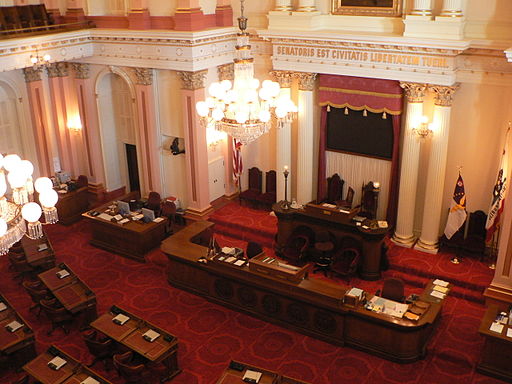In 2016, California passed Senate Bill No. 1383, which is geared toward reducing the amount of organic waste going to landfills in California. According to CalRecycle, the agency charged with manager SB1383, approximately a third of the material in California landfills is organic and, therefore, could be composted. In this article, we will be discussing SB1383 and other examples of California Compost Law to provide an overview of the work that California is doing to increase composting and reduce organic waste in landfills within California.

The Drive Behind California Compost Law
We have all heard of climate change, and there are varying opinions on the cause of it. That’s not our role here. Here is what we do know:
- The planet’s average surface temperature has risen about 2 degrees Fahrenheit (1 degree Celsius) since the late 19th century. Increased carbon dioxide in the air acts as an insulator, trapping warm air in the environment.
- The ocean temperature, particularly in the upper 100 meters (about 330 feet) has risen more than half a degree Fahrenheit (0.33 degrees C) since 1969. This is where much of the increased temperature is going. Oceans act as a store of energy for the planet. This leads to expanding oceans (sea level has risen about 8 inches in the last century, which is immense), more violent weather and more rain and thunderstorms.
- The Greenland and Antarctic ice sheets have decreased in mass. Data from NASA’s Gravity Recovery and Climate Experiment show Greenland lost an average of 279 billion tons of ice annually between 1993 and 2019, while Antarctica lost about 148 billion tons of ice annually.
- Spring snow cover in the Northern Hemisphere has decreased over the past five decades. Additionally, the snow is melting earlier.

This significantly impacts high temperatures, forest fires, violent weather, and water supplies. That affects insurance premiums, insurability, and livability in general. Estimates are that California’s water supply could be reduced by up to 10% in the next two decades, with some areas already facing shortfalls.
California has several problems that it faces tied to climate change. One of the main causes of climate change is greenhouse gases, such as carbon dioxide. Carbon dioxide can be formed by several sources, such as burning fossil fuels, agriculture (cows are a major source), manufacturing, and landfills. As the material breaks down in landfills, it produces methane, a major ingredient in natural gas used to cook and heat. It combines with oxygen in the upper atmosphere to produce carbon dioxide.
With about a third of the waste in landfills being organic, this gives us a major opportunity to reduce much of the emissions from landfills. We do this by composting that organic material or allowing it to decompose naturally into its parts to form compost. That compost is added to the soil of gardens, lawns, and flower beds. It then creates healthier soil for our plants and food which can be grown with less fertilizer. Less fertilizer means less manufacturing and fewer chemicals in water supplies.
Composting has these and many other benefits. It’s a true example of the Circle of Life we learned about in Disney’s The Lion King. The difference between organic material breaking down in a compost pile versus a landfill is that we take advantage of natural microbes, worms, insects, and other helpful organisms by providing the right conditions and including enough air, water, and heat for the natural process to happen. Landfills don’t allow this. The material rots in a landfill without the necessary oxygen, creating methane.
California compost law recognizes this and is trying to create the right conditions to reduce organic waste in landfills and promote us composting more.

Senate Bill 1383 – A Drive to Improve Composting Within California
A major step in California compost law was SB1383, trying to promote more composting and composting opportunities. It aims to reduce organic waste disposal by 75% by 2025, the equivalent of removing 1.7 million gas-powered cars from the state’s roads. This could significantly impact the size of California’s landfills and the associated methane emissions.
Cities are required to implement composting programs or face significant fines. California residents and businesses must separate organic material for composting from other garbage, as we have in many places for recyclables. As we have seen with recyclables, the items they are composting vary somewhat from area to area, but generally, it’s food scraps and yard waste. Municipalities provide households with bins for separating their organic material and associated waste collection services. These services are often the same ones that provide traditional trash pick-up.
Businesses are also required to provide places for customers to dispose of organic waste like the recycling bins we are used to.
Single Family Residents and Multifamily Complexes of Less Than Five Unit Requirements
With the implementation of SB1383, each of us has requirements. Let’s take a look at the main responsibilities:
- Residents must participate in their jurisdiction’s organic curbside collection service.
- Residents are required to properly sort their organic waste into the correct containers.
- Some jurisdictions will allow residents to self-haul their organic waste. If this is the case, the jurisdiction will provide information about self-hauling requirements.
Reduction of Surplus Food Under SB1383
In addition, while not composting, it also promotes the rescue of disposing of surplus food by at least 20%. On a global basis, we waste about 1.4 billion (yep, you read that right) tons of food every year. This is the food we throw out at home, uneaten food at restaurants, and grocery stores that throw out food that hasn’t been purchased, much of which is still edible. There is much opportunity beyond composting to ensure people who need it. In California, there are over 160,000 homeless that could use some of that food, not to mention the one in four families in California that can’t afford to eat.
CalRecycle – The Organization Managing Recycling and Composting within California
To meet these goals, CalReCycle has created an organics management program. This program provides information on home and commercial composting operations, where to get bins, how to start your program, and much more.
They oversee the operations of commercial compost facilities and traditional waste disposal and recycling centers. They provide a directory of facilities within the state. There is a tremendous amount of information on their site.
California Compost Law – Composting People
As a true example of composting anything organic, as of 2027, you will be able to compost yourself or your loved ones when they die, rather than cremating or burying them. Under Assembly Bill 351, it will then be legal to compost human remains. This is a process very similar to traditional composting. The body is placed into a vessel with brown materials, and then they allow the body to decompose. This process, called Natural Organic Reduction (NOR), allows decomposed remains to be added to soil, spread out over a favorite spot, or otherwise used much like cremated remains.
California joins four other states that allow human composting: Washington, Oregon, Colorado, and Vermont. New York is also considering allowing human composting.
To understand why California would do this, it’s worth looking at the environmental impact of cremation – which is a lot more than you might think.
- The average amount of fuel for one cremation could power a house for a month
- The carbon dioxide produced from one cremation produces about 535lbs of CO2. That’s about the same as a 600-mile drive in an average-sized car.
What to Expect from Your California Composting Program
Each program varies, but they have some commonalities. We will discuss the general concepts of what you should expect and how you can manage to compost in your own home but make sure to check with your municipality before you add anything to your compost bin.
Compostable Items for Municipalities
The items that each municipality allows vary a bit, but there are some common items. Check with your waste collection provider, but here is what you can expect for items that you can compost:
Yard
- Grass Clippings
- Leaves
- Weeds
- Prunings
- Flowers
- Wood Scraps/Chips
Kitchen
- Fruit
- Bread
- Fish
- Meat
- Vegetables
- Dairy
- Coffee grounds and filter
- Food soiled paper
Some locations will accept paper products such as napkins and unwaxed paper plates, but some do not (or they consider them recyclable.)
Items That Should Not Go In Municipal Compost Systems
Here are some items that you should not expect your city or town to compost:
- Compostable or biodegradable plastic
- Compostable or biodegradable cups and other containers
- Plastic bags
- To-go coffee cups (or lids)
- Milk Cartons
- Palm Fronds
- Yucca
- Agave Americana
- Poison Oak
- Bamboo
- Can You Compost Dog Poop? – Absurd? Maybe Not, But Be CarefulPet, or Human Waste
California Compost Law – Making Progress
California is typically one of the first states to pass environmental laws. Composting is no different. Few other states have goals as aggressive or measures as strict statewide. Their goals are aggressive, and they may have some difficulty meeting them. It will be interesting to watch their progress.
